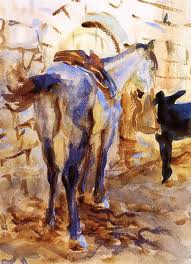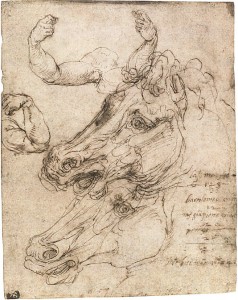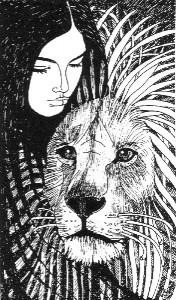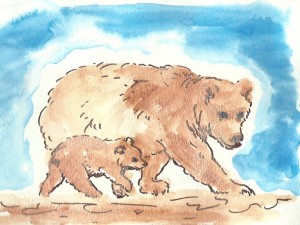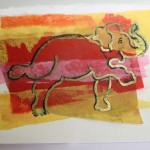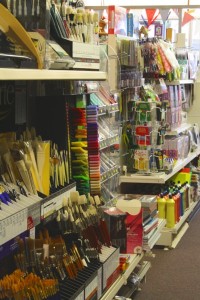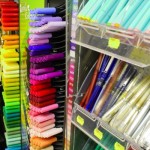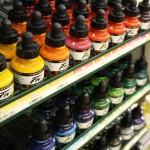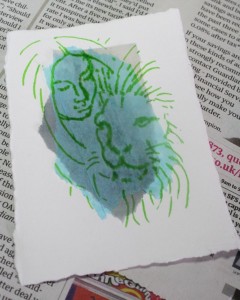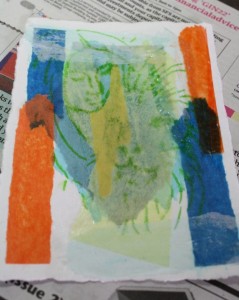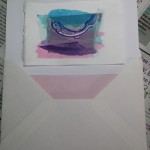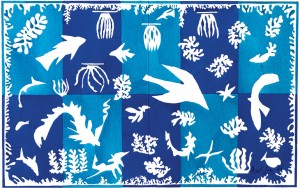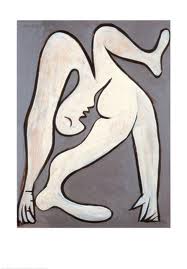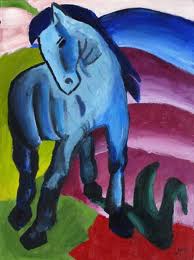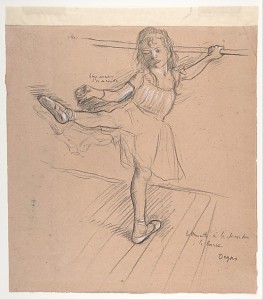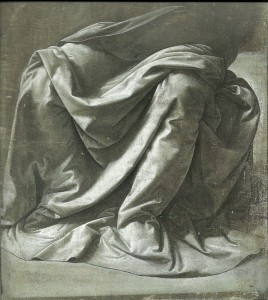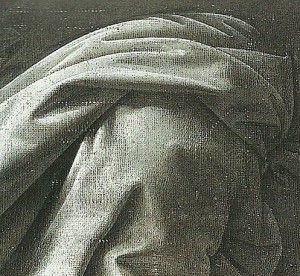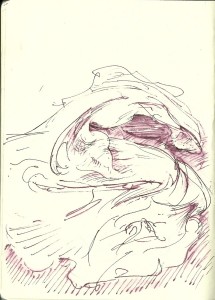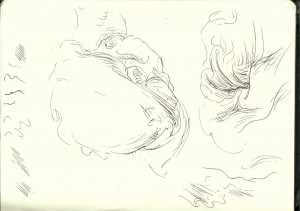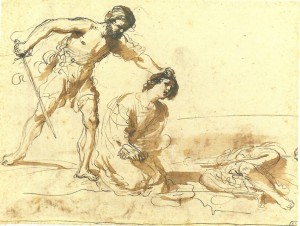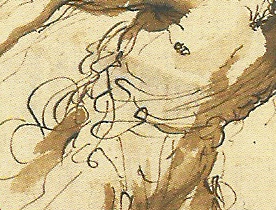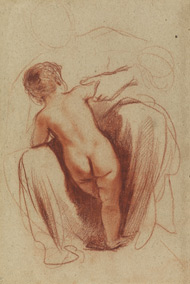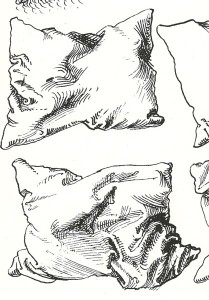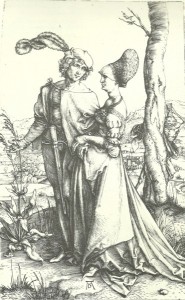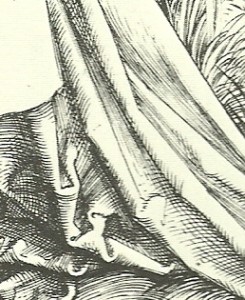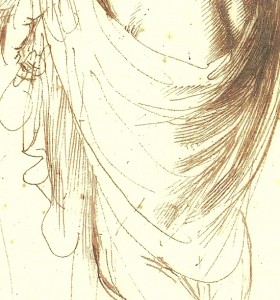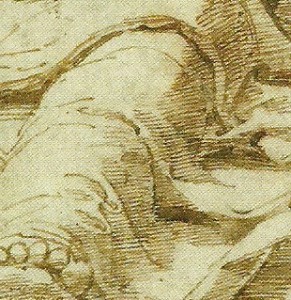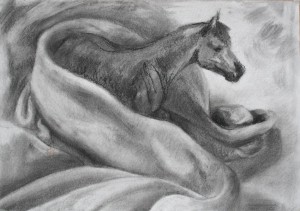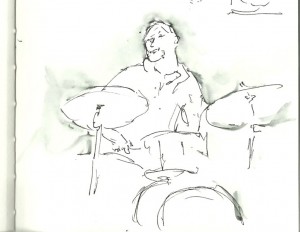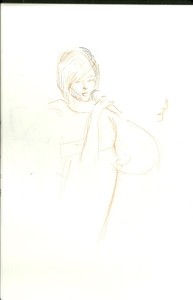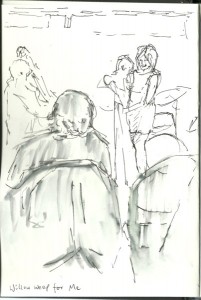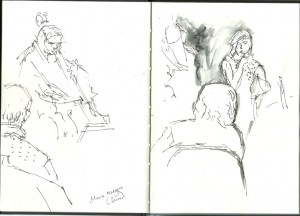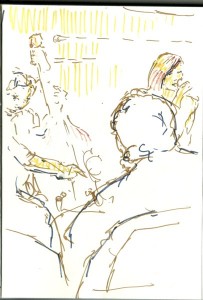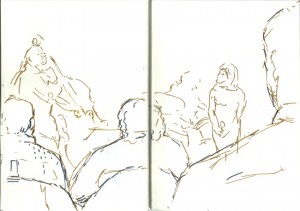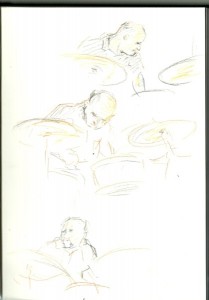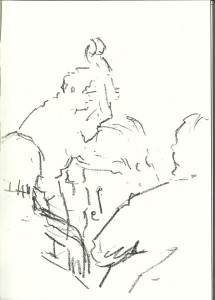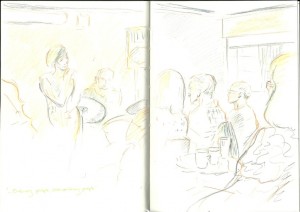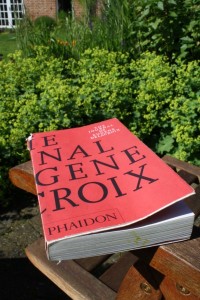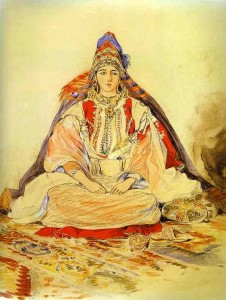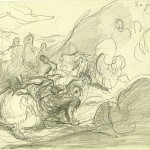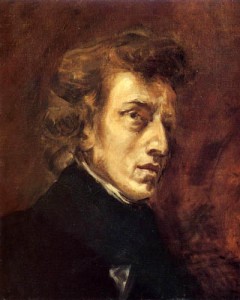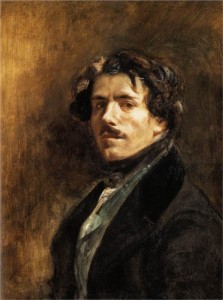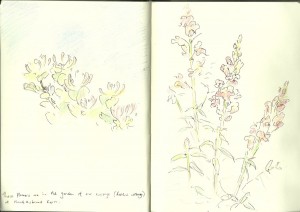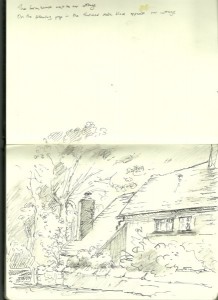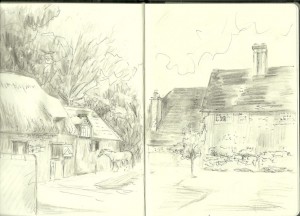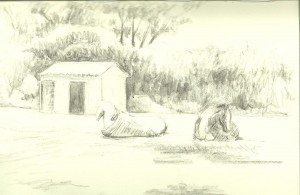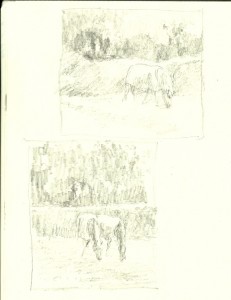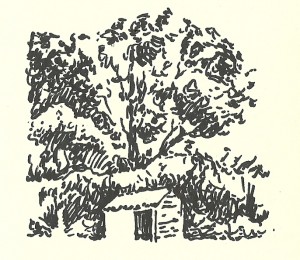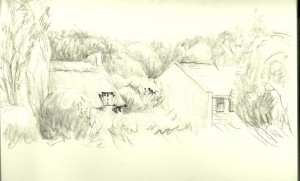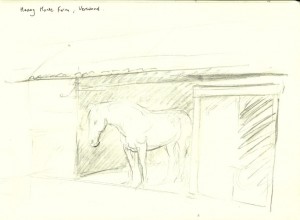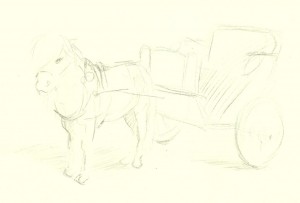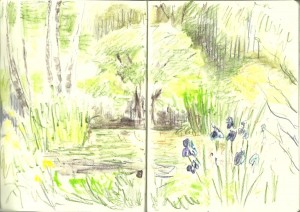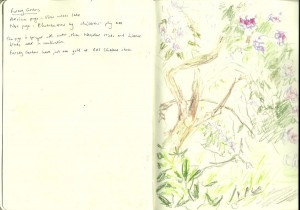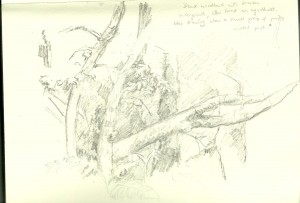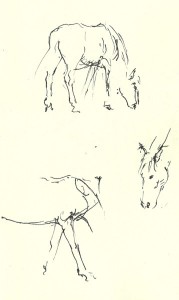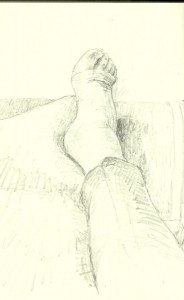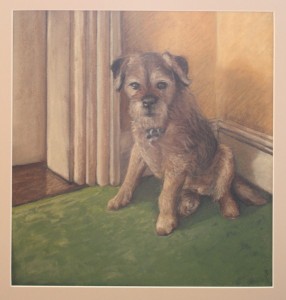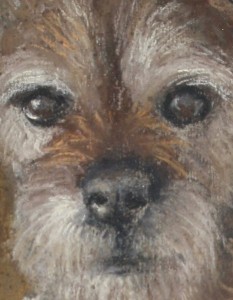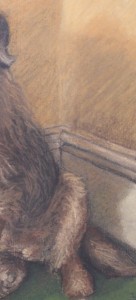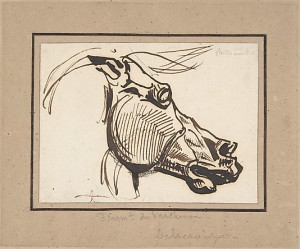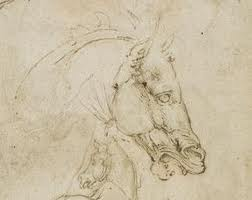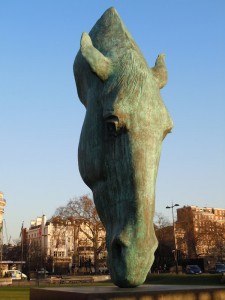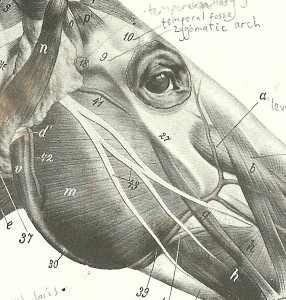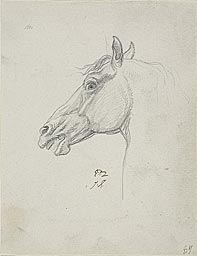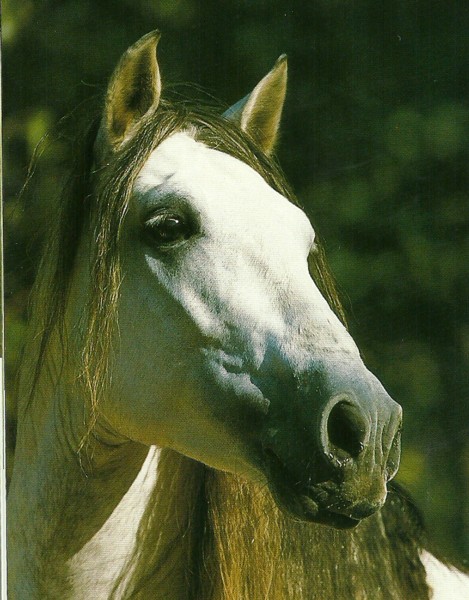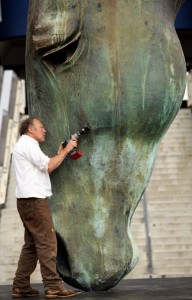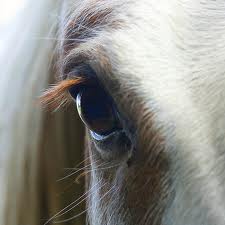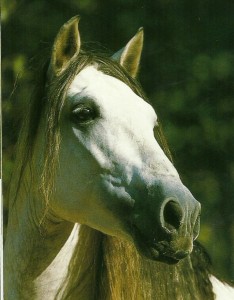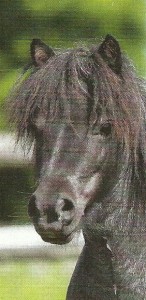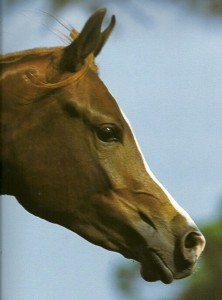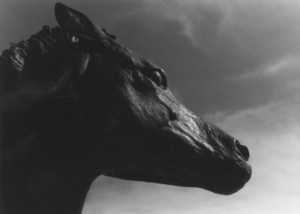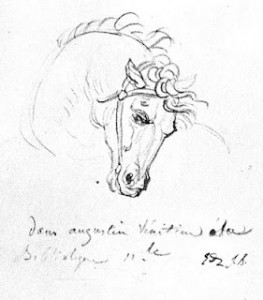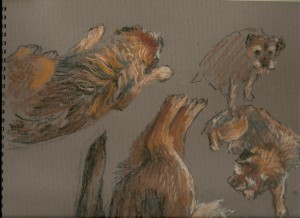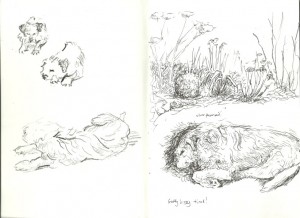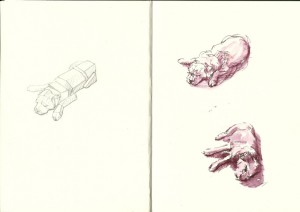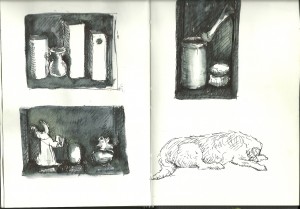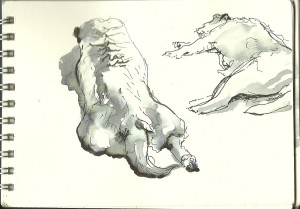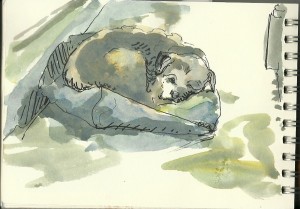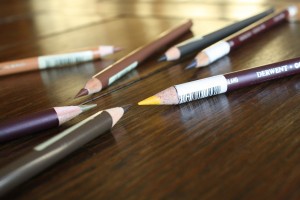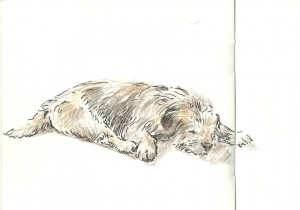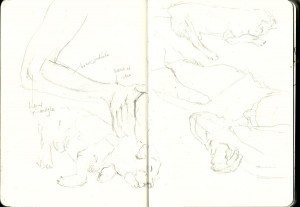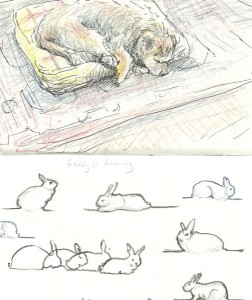The next horse life drawing workshop will be on 30 September 2012
July 14, 2012
Life drawing with a difference: The model is a horse!
Above: J.S.Sargent “Saddle Horse, Palestine” (watercolour,1905)
What happens in an “equestrian life drawing workshop”?
One or more horses are used as models during the day. These are held as still as possible by experienced handlers.
Artists draw or paint at easels around the horse, just as in a standard life drawing class.
If weather is fine then we work outdoors; if wet then we use a covered barn.
Most materials are supplied (paper, charcoal, chalk, graphite and a few surprise bits).
Plenty of tuition and guidance is given, though you’re also welcome to “do your own thing” if you prefer.
The workshop takes place on a farm with a whole range of animals. You are welcome to wander off and draw other species if you wish.
For a look back at our May 2012 horse life drawing session click HERE.
Above: photo of “Polo” the horse durng the May 2012 life drawing session
Who can come?
All are welcome, from novice to experienced artists.
If you do not yet have much drawing experience, a few human life drawing sessions would be good preparation for you before this workshop.
At the other extreme, if you are a very experienced artist you may wish to come just for the experience of having an equine model held for you all day. If you want to work without any tuition or comments then just let me know this when you book (or when you turn up). This could be your chance to do some interesting watercolour or oil studies or whatever you like.
Where, when and how much?
Date: Sunday 30 September 2012
Time: 10-3pm
Place: Standon Green End Farm, SG11 1BW. This is near Hertford and Ware in Hertfordhire, and is close to the A10 and to the A602.
Cost: £25 per person for the whole day including tuition and materials. It is an extra £5 to hire an easel (please bring your own easel and backing board if possible).
How to book
Contact me by clicking here (or by phone or email if you already know me).
I am very happy to answer questions, and can then post or email further details, directions and a booking form to you.
Above: Perino del Vaga “Studies of a Horse Head” (Rome 1501-1547)
Comments (2) | Tags: equestrian life drawing, Herts, horses, workshops
Ideas for making cards, and I feature Tim’s the local art shop
July 8, 2012
How should an artist go about making cards?
I am currently putting together some ideas for a workshop on card-making for artists. The more I think about it, the wider the topic seems to be. Whatever the technique used, here are a few general pointers:
“Some golden rules of card-making”
However interesting the image, it needs to be “eye candy” (i.e. very pleasing).
The design as seen from a distance is more important than the detail.
Blank space around your design can be attractive.
When choosing colours, consider how the card will look on a mantelpiece or wall. Lay colours next to each other and check how pleasing the result before starting the image.
An appealing theme is a good idea (e.g. mother and baby animals) but design trumps theme. An outstanding design using a simple heart or birthday cake silhouette can be quite sufficient.
Getting started
If you already have artwork that looks good from a distance, this can be scanned or photographed and reproduced as cards. To use the original picture directly, mount it onto a card blank using Spray Mount.
Some of your artwork may not be good enough to frame but perhaps contains one or more beautiful sections. These areas can be cut out and used. For example, you may end up with part of a figure, or even just an abstract design with beautiful colours and shapes that can be mounted onto a card blank. This is a really good tip for making use of artwork that would otherwise be discarded.
New ideas for cards
In the workshop, there will be the opportunity to try out three arty craft methods:
Ink and pen images
Silhouette techniques
Tissue paper and pen layering (see further down for guided instructions)
Believe it or not, the elephant design (above) was taken from a photo of a pregnant elephant who was trained to do birthing exercises.
Art and craft shopping in Herts: Where to buy your stuff
Shopping for card-making is a real pleasure. For these cards, I have used FW acrylic inks, Staedtler Triplus Fineliner pens and various colours of tissue paper, card blanks, PVA glue, various brushes, coloured card and Pilot gold and silver pens.
So, where should one go to buy this stuff in Hertfordshire? I highly recommend Tims Art Shop in Hitchin which is where I source most of my craft products and art materials. You’ll find this shop next to the market in Hitchin town centre.
The photos above and below were taken in Tims. Here I’m just showing small sections of their craft selection. They are also really well-stocked in everything you need for the fine arts from dip pens to oil paints.
The staff are always friendly, and over the years have been great at pointing me in the direction of products that do indeed prove to be the most useful.
For the shop’s opening hours, contact details and information about their mail order service, click here to reach Tims Art Shop website.
Instructions for tissue paper layered designs
I do enjoy making these tissue paper designs as it gives me a chance to draw outlines at the same time as playing with colours and shapes. This sounds like nursery-school stuff but please do read on.
You will need:
Small (approx 8 by 8cm) piece of watercolour paper Scrap of opaque paper of your choice, e.g. newspaper or sugar paper Tissue paper in your choice of colours Felt tip pens (I used Staedtler Triplus Fineliner) PVA glue and a small old brush Pilot silver or gold pens (optional) Small “sticky fixers” Card blank and envelope Inspiration for your designMethod
1) The piece of watercolour paper forms the backing for your design. Lay this out, and glue a piece of opaque paper on top. The opaque paper can be torn and placed fairly casually. For sticking, I suggest using PVA glue diluted about 2:1 with water. I make them in batches:
2) Tear off a piece of tissue paper, aiming to get it a little smaller than the glued opaque paper. Use the diluted PVA to glue it on top:
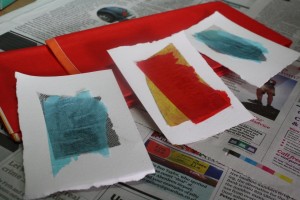
3) Draw the basic design directly onto this tissue paper layer using a felt-tip pen. I recommend using a mid-tone pen (so not pale yellow or jet black) at this stage. In the example below, I have copied the design from my own black and white lady and lion image (see here) that I had drawn some years ago in pen and ink:
4) Tear off more small odd shapes of tissue paper and glue them, in places, on top of your drawing. Your initial drawing should be just about visible through the fresh layer of tissue paper. Play with “balancing” colours and shapes within the image.
5) Trace over parts of your initial drawing using your choice of pen colour. It often works well to use some black in the final drawing. Some of the underlying drawing shows through, creating an interesting effect. If you make small drawing errors, or if you want to make part of your drawing less prominent, glue a piece of white or other pale tissue paper over that section. You can glue more tissue paper layers and redraw as many times as you like.
6) To finish: Find a card blank of appropriate size, or cut a piece of card and fold it. Attach eight tiny sticky fixers to the back of your design, one on each corner and one at the centre of each edge. Position the design carefully on the blank card and press down to fix in place.
Examples:
Here is the completed Lady and Lion card. The lion’s expression looks a bit odd here as I have added a little gold pen over his eyes and this has caught the light in the photo:
The following design was based on a fossil fish! I added silver pen lines when the glue was dry:
Further ideas
I enjoy looking at the overlap between craft, design and “fine art”. For fantastic inspiration for silhouettes, linear and flat colour card designs, look at these artists among others…
Henri Matisse
Franz Marc
Comments (1) | Tags: cards, collage, Herts, shopping
Workshops for Summer/Autumn 2012
July 5, 2012
Here is a list of themes for upcoming art classes. Please get in touch for more information.
For information about the paintings and drawings within this post, just scroll your mouse over each picture.
Small group art improver course
Themes for upcoming art classes
Six sessions are planned. These can be booked individually or save money by booking as a block:
Drawing children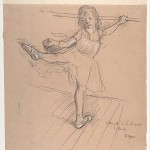 (Fri 10 Aug, 11:30-1:30pm; £10) FULLY BOOKED
(Fri 10 Aug, 11:30-1:30pm; £10) FULLY BOOKED
Two child models, boy and girl, will pose in gymnastics gear. We’re planning fun poses and interesting balance poses today to reignite everyone’s interest in life drawing.
How to fit people into landscapes (Fri 24 Aug; 11:30-1:30pm; £9)
Do you ever draw or paint a landscape, interior or street scene and try to add a figure? Are you left feeling that the person doesn’t “fit in” in some way? There can be several issues involved here. I’ll discuss them all and shall refer to a variety of pictures, especially Impressionist paintings. Working from photos (supplied or bring your own).
The draped figure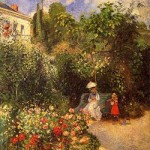 (1) (Fri 7 Sep; 11:30-1:30pm; £12.70)
(1) (Fri 7 Sep; 11:30-1:30pm; £12.70)
Adult clothed model this time. If weather fine, we shall work in the garden following on from the previous session. If cold or wet, we work indoors and look at the clothes themselves on the figure, e.g. how do folds and creases appear over limbs and body, and what to do about necklines.
Pen techniques for landscape (Fri 21 Sep; 11:30-1:30pm ; £9)
Mastering the use of the pen involves coming up with a “language” of pen strokes to represent things, from clouds to edges of buildings to foliage to human hair. Landscape drawing is the best way to get started on this. We have the choice of working from photos, views through the windows, or drawing from Old Master paintings (an excellent way to learn).
Pen and wash techniques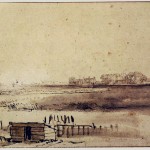 (Fri 5 October; 11:30-1:30pm; £9) FULLY BOOKED
(Fri 5 October; 11:30-1:30pm; £9) FULLY BOOKED
This follows on from the previous session. I’ll show you various techniques of combining pen lines with washes of dilute ink. We’ll take a look at landscape drawings by Rembrandt and figure drawings by Guercino and others and shall work from photos of landscapes and/or figures.
The draped model (2) (Fri 19 October ; 11:30-1:30pm; £12.70)
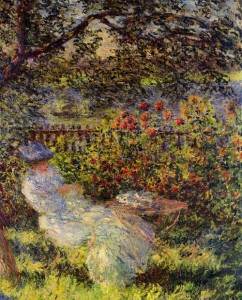 I’ll be sure to cover different material to the previous draped model session. If weather is good then we shall work outside. I’m happy to help those who wish to make use of this and work in colour.
I’ll be sure to cover different material to the previous draped model session. If weather is good then we shall work outside. I’m happy to help those who wish to make use of this and work in colour.
Some further details about these art classes:
Where?
Codicote, Herts, near junction 6 of the A1(M). Please get in touch for address and directions.
When?
Approximately every fortnight from August to October. Friday late mornings, 11:30-1:30pm. For each session, artists are welcome to arrive up to half an hour early in order to grab a coffee and set up, etc.
Cost?
If you pay in advance for the block of six sessions, total cost is discounted to £54.40 (payable by cash or cheque by 10 August). If attending individual classes and paying on the day, the cost of each session is as listed in their description, above. So each class costs in the region of £9 plus a small model fee where applicable.
Who can come?
Artists at any level as I give plenty of individual feedback. If you are a complete beginner, you may prefer to do my foundation sessions first (covers measuring, basic perspective, etc.) to give you more confidence. Contact me here for more information about the foundation classes and/or for the workshops listed in this post.
What happens in a session?
Anyone who wants a chat, a cup of coffee or tea and/ or a better look at my art books can arrive up to half an hour early. Each session has a theme and I always come prepared with ideas and printed notes for everyone to take home with them. After a little discussion, everyone gets down to drawing. For a post about my recent class on “drapery”, click here. As you may gather, I have a library of art books and we often refer to Old Master drawings and paintings.
Comments (5) | Tags: classes, Codicote, Herts, workshops
Drapery for artists: Why bother with it?
July 2, 2012
Today I review a few uses of drapery in art and investigate whether or not drapery can be exciting.
Above: Dominique Ingres (1780-1867) Study for the Drapery of Moliere in the “Apotheosis of Homer”, black chalk with stumping, 12x10in
Last week’s drawing classes on drapery
My initial thought, on being asked to teach classes on drawing drapery, was that this is a dry and uninspiring subject. But do read on, as I eventually started to change my mind.
Fabric folds are complex and it takes sustained concentration and technical skill to create an illusionistic image. I fear starting to draw and getting “lost” in the complexity of the folds, helpless and confused as if in a nightmare involving spaghetti.
The first drapery images that come to mind are those truly illusionistic studies by Leonardo da Vinci and his contemporaries. Above is one of his drapery studies for a seated figure from the 1470s. The amazing three-dimensional appearance of this fabric is created by the build up of tones of grey and white tempera, indicating the light falling on the intricate folds. It is said that Leonardo would soak fabric in dilute plaster and then arrange it over a mannikin and leave it to set in place, thus allowing study over a long period. This would presumably allow him to return at the same time each day to ensure that the fall of light on the subject did not alter when he was working. Below is a detail from the same image:
Towards the end of the workshop, I shared a method of working in compressed charcoal on white paper that allows a similar build-up of tones. A putty rubber is used to create highlights, and stumping is used to blend tones and to increase the depth of the shadows.
Before getting too engrossed in this rather technical way of working, we discussed how drapes can suggest movement and energy, and attempted some very loose warm-up drawings of fabric based on drawings by Guercino.
Fabric, movement, energy and emotion
The great thing about fabric, for artists, is that we can do what we like with it. While the appearance of figures is limited by anatomy, a scarf or cloak can be arranged with great freedom, swirling or billowing to energise whichever part of the picture that we choose.
A master of this was the great draughtsman Guercino (1591-1666, Italy). His figure drawings are known for conveying great emotion. When working in pen or brush and ink, he would use very free, swirly lines to suggest movement or emotional turmoil and he made great use of any fabric to heighten this effect.
Above is one of Guercino’s studies for a subsequent painting of “The Martyrdom of Saints John and Paul”. One of the faithful men who is about to be beheaded kneels in the centre. His body is suggested by a few pen strokes and sweeps of brown wash that represent the folds of his cloak. The expression on his face is upsetting to view, but the gentle sweeping marks of his cloak suggest a quiet, passive, enclosed figure.
The executioner on the left is viewed at a moment of stillness, grasping the saint by his hair. His hands and feet look, to me, rooted to the spot, but there is an energy bubbling at the centre of this figure. Below is a detail from this image, showing the swirly lines of drapery at his waist. This man is about to make a terrible violent swipe of the sword. This does not look like a cold, calculated execution. The lines around the standing figure suggest bubbling anger and wrath.
Now take a look at this famous red chalk drawing by Guercino, “A child seen from behind, standing between his mother’s knees”. The fabric of the mother’s skirt forms a warm, enclosed space for the figure of the child. Once again, drapery has been used to suggest emotion:
Fabric and composition
Guercino’s mother and child drawing, above, also demonstrates how the shape of drapery can make an interesting composition. Areas of dark tone form two-dimensional shapes within the picture. This is also the case with light-toned areas bounded by lines. These shapes surround and visually balance the central figure of the child.
Also consider the type of shapes within the fabric. Different shapes in pictures can hint at different emotions. Most of the shapes in this mother and child picture are rather elongated with one or more gently curved edges. Such shapes suggest a peaceful, gentle rocking. There are no explosive-looking jagged or rigid blocky shapes within the fabric of the mother’s skirt here.
For a fabric study with a more explosive feel, take a look at this one in black chalk by Dominique Ingres:
This drawing is a wonderful composition of triangles and boomerang-like forms rotated and repeated around the picture. It is a study of folds within fabric, but has the feel of a successful abstract composition. Indeed, it seems that drawing fabric is one good entry point to the realm of abstraction.
Back to reality
Once we have arranged our fabric on the table, hanging on the wall or on a mannikin, how should we go about drawing it? For the second half of the session, artists in the drawing classes had the choice of working in either pen and ink, or in stumped charcoal.
Pen lines can convey the form of fabric folds and the position of light and shade. Working in pen, the artist rarely aims for pure illusion as blended tone cannot be achieved. Each artist comes up with their own system in which lines are used to suggest structure and tone.
One traditional method is to draw “cross-contour” shading lines curving over the fabric folds. In areas of deep shadow, there are many cross-contour lines and some lines cross-hatched in the other direction. Light-toned areas are kept free of cross-contour lines. This method was used by Albrecht Durer in his pen and ink drawings:
Albrecht Durer: study of pillows (detail)
…and in his engravings:
Albrecht Durer: “Young couple threatened by Death” 1498 (detail of drapery shown below whole image)
If emphasising the weight or flow of fabric hanging between creases, it is sometimes best to take the shading lines in the direction of that weight or flow. Here is another drawing by Guercino, this time showing how shading lines are can be taken parallel to the main fold lines instead of across them:
Guercino: “Bathsheba attended by her maid” , 1640, pen and ink (detail is shown below main image)
The third method of linear shading involves taking parallel diagonal lines “hatching” across any parts of the image that are in shadow. These hatching lines are combined with some edge lines. In the drawing, below, by Mantegna, almost all of the shading lines within the figure and drapery are taken diagonally from left up towards the right. The shadow on the right side of the stone slab is, though, made of horizontal lines.
Andrea Mantegna: “A man lying on a stone slab” 1470s, pen and ink (detail is shown below main image)
What now?
As an artist, it is encouraging to see that one need never be bored again. All it takes is a scarf, a pillow or any scrap of fabric and a new composition can be formed.
There is a wealth of possibility in arranging fabric and objects or figures. I have started playing with other ideas. What about, for example, wrapped bananas?
Or wrapped horses?
…the possibilities are limitless….
| Tags: Drapery, Guercino
Sketching at last night’s jazz concert: The Georgia Mancio quartet
June 25, 2012
Yesterday’s Herts Jazz Club concert in Welwyn Garden City
Sketches of the Georgia Mancio quartet
My husband and I enjoyed the jazz performance at Campus West last night. I took along my usual sketchbook and few pencils and pens. Here are the resulting sketches. Roll your mouse over each picture for a little extra information.
Georgia Mancio led the group. Her voice has a very pleasing warm tone and she relishes the words of the songs. Below she is singing Ann Ronell’s “Willow Weep for Me”. The bassist on the left is Mark Hodgson. As you can see, we didn’t get front row seats:
These Pitt pens by Faber-Castell are fun, bold and permanent, so can be overlaid with a wash of watercolour or ink if desired.
Dave Ohm, on drums, performed some amazing solos:
and we were astonished by the skill of the bass player, Mark Hodgson. I used a black chinagraph pencil for these bold lines:
I could not see much of the pianist, Tim Lapthorn, from my seat. There is a glimpse of him with his back to us to the right hand side of this picture:
The audience cannot be forgotten. Here is my view of people focusing on Georgia as she sings “I’m Glad there is You”:
“In this world of ordinary people/ extraordinary people / I’m glad there is you”
Links
| Tags: musicians, sketchbook
The Journal of Eugene Delacroix: Ideas and inspiration
June 20, 2012
A review of “The Journal of Eugene Delacroix”
I have thoroughly enjoyed absorbing this book bit by bit over the past few months. It is not only an intimate portrait of Delacroix, but also sparkles with ideas about human nature, art, the natural world, music and philosophy.
My personal interest in Delacroix
It was initially a different book that ignited my interest in Delacroix, Arlette Serullaz’s “Delacroix”, one of the “Louvre Drawing Gallery” series.
I had been amazed by the variety of drawing styles showcased in Serullaz’s book, from carefully decorative (see “Jewish Bride in Tangier”) to gestural (see “Thrown horseman in a landscape”), and from studies of the natural world (see “Head of Lion Roaring”) to envisioned images (see “Hamlet and his father’s ghost”).
To identify pictures in this and other posts, scroll over them with your mouse.
My first thought was that the artist who produced such a wealth of images must have had a constant stream of ideas and an open mind.
On investigating Delacroix further, I read that he is renowned for his feverish imagination, but also had an unusually logical approach to his work, for example making rigorous notes on colour mixing. This combination of inspiration and logic in an artist is fascinating, so the next step for me was to read his journal.
My copy of the journal
I have the paperback version published by Phaidon, “The Journal of Eugene Delacroix” tranlsated by Lucy Norton, edited and introduced by Hubert Wellington.
A huge amount of content is packed into this slim volume, the text printed on amazingly thin paper followed by 81 black and white plates. Including appendices and index, this portable little book contains a surprising 570 pages.
An overview
The journal runs from 1822 (when Delacroix was 24 years old) to a few months before his death in 1863. Delacroix noted down all kinds of thoughts, from immature ideas about pretty girls or concerns about money, right up to philosphical discussion on what is and is not art.
It includes a fantastic cast of famous characters from Delacroix’s social circle. As I have a musical background, the most interesting of these to me is the composer and pianist Chopin (below) who was an intimate friend of Delacroix.
There is also mention of the great violinists Paganini and Ernst, and Delacroix wrote of his conversations with George Sand, Alexandre Dumas, Charles Baudelaire and many others.
 Fascinating to me is the relationship between Delacroix and his servant, Jeanne-Marie le Guillou (“Jenny”), who worked for him devotedly from 1834, cared for him through his illnesses and on his deathbed, and did what she thought was best to safeguard the notebooks after his death.
Fascinating to me is the relationship between Delacroix and his servant, Jeanne-Marie le Guillou (“Jenny”), who worked for him devotedly from 1834, cared for him through his illnesses and on his deathbed, and did what she thought was best to safeguard the notebooks after his death.
A Breton peasant woman who had been through great hardship before coming into Delacroix’s service, Jenny nevertheless had a good appreciation of art and, at times, her comments were highly perceptive. For example, in the diary entry from 12 October 1853, Delacroix described how he was walking in the forest with Jenny (they were frequent walking companions) and discussing forest painting, “she remarked with her great good sense: ‘Exact imitation is always colder than the original.'”
Themes covered by the journal
Here I shall list the themes within the journal that most appealed to me. Delacroix had far, far more to say on each subject than the odd snippets that I have included here. If you are curious about one or more of these then get in touch, as I can add details about specific topics in future posts.
What is art?
“Painting is nothing but a bridge set up between the mind of the artist and that of the beholder” (25th January 1857)
On 12 October 1853, Delacroix discussed the way in which the artist can work carefully from a model within the context of an imaginative picture, and in so doing, “…You will have introduced reality into a dream, and united two different arts”.
On 15 September 1854, “How strange painting is, it delights us with representations of objects that are not pleasing in themselves.”
Boredom
It seems that Delacroix fought quite a battle against boredom and had many ideas on the subject. Reproduced in the journal is a letter to his friend and cousin Mme de Forget on 25 August 1854 in which he wrote, “…I seize every opportunity to occupy my mind , even down to discussing the boredom which I so much want to exorcize.”
Complex personalities
Delacroix was fascinated by the variety of human characters. From 23 February 1858: “…The variety of opinions held by different men is astonishing enough, but a man with a sound intellect can conceive every possibility, and can make his own or understand every different point of view…”
Learning, study and knowledge
Delacroix had much to say about learning and knowledge. Although he was forever reading, he wrote on 5 October 1855, “…I can learn far more by looking than the inventions of any scribbler could teach me”.
Notes on picture-making
There are plenty of ideas on the practical process of picture-making, from the laying-in process, to the use of finishing touches, and from the use of tones to specific paint colour choices and thoughts on edges and visible marks.
Observation of nature
Delacroix loved to walk in the countryside and he observed nature closely. Scattered throughout the journal are observations on what he has seen, from the colour of a slug and the behaviour of insects, to the shapes of trees and rocks and the appearance of water and marks in the sand.
Dictionary of Arts
Delacroix hoped to create a dictionary of the fine arts. This task was never completed, but he compiled many ideas and definitions which are included in the journal from 11 January 1857.
Thoughts on other artists
Delacroix discusses the work of other artists. Even those that he loved as “Old Masters” were analysed in a critical way, from Michelangelo to Rubens. His thoughts on writers and composers are also fascinating.
Suppress unnecessary details within a picture
The importance of avoiding too much detail in a picture is a recurring theme throughout this artist’s journal. For me, this is the book’s practical “take home message”.
On April 23, 1854, he talks of the failure of a mediocre artist to “…keep the first pure expression throughout the execution of their work…. Can a mediocre artist, wholly occupied with questions of technique, ever achieve this result by means of a highly skilful handling of details which obscure the idea instead of bringing it to light?”
Realism
What is the importance of accuracy and realism within a painting? This is another recurring theme of the journal, tying in with Delacroix’s thoughts on leaving out unneccessary visual details.
On 9 October 1855, he writes of painting boats: “What I require is accuracy for the sake of the imagination.” He scorns the average marine painter: “Their ropes are mere lines, drawn in hastily and according to formula; they are put there simply as reminders and serve no real purpose.” And he goes on to say, “My kind of accuracy, on the other hand, would consist in strongly sketching in only the principal objects, but in such a way as to show their essential functions in relation to the figures in the painting”.
The aims of the artist
Delacroix has numerous thoughts on this subject. He writes of originality of ideas, seeking perfection and aiming for the impossible. Delacroix discusses instinct, inspiration and discipline, and idealisation, reality and dreams. There is a passage on being beyond ourselves, and another on expressing the effect of the moment. He also writes of imagination, the conception of an image and the supreme image.
Ideas and inspiration
As you might expect, this is a major theme of the journal. Delacroix discusses the matter of conceiving ideas for pictures. He writes of a freedom and wealth of ideas, and of how the artist needs some daring. There is a section on inspiration and ongoing discoveries.
Delacroix describes how inspiration may be suppressed by prejudices and also by habit: “In the arts especially, a man needs to possess very deep feeling if he is to maintain his originality of thought in spite of habits which even talented artists are fatally prone to acquire” (March 1st, 1859).
And take note of this, from 8 March 1860: “An artist should not treat himself like an enemy. He ought to believe that there is value in what his inspiration has given him”.
Other artist’s memoirs and journals
Delacroix’s journal leaves me wanting to draw and paint, and also to look at the world more closely. However, I wonder what is out there for future reading. Can anyone recommend other interesting pieces of writing or discussion by artists?
Delacroix’s journal itself does not include much on his 1832 Moroccan journey. He did make many sketches and notes abroad but only a few pages of this writing (without the corresponding sketches) are included in my Phaidon edition. Perhaps I should get hold of the book, “Delacroix:Moroccan journey“? Any book recommendations would be gratefully received.
| Tags: books, Delacroix
Holiday on Hucklesbrook Farm
June 14, 2012
A week in the New Forest, Hampshire, UK with my family.
Today I share some pictures from my holiday sketchbook.
There are four holiday cottages on the farm. We stayed in “Fallow“, just opposite the farm’s thatched stable block. I don’t seem to have drawn our own cottage, but here is the horses’ lovely accommodation as seen from our door:
Each of the holiday cottages has its own lawned garden with honeysuckle and other cottage garden flowers:
The farm is clean, tidy and chocolate-box pretty. Here is the lovely old farmhouse with its tiled roof and tall chimneys:
And here a view of the yard bordered by the thatched stables and the farmhouse. In reality, there is a neat wooden fence around the stable block which I have not included:
Within limits, the children had the chance to wander around the farm, collect eggs, play football and play on swings. Apart from the horses, there are chickens and these white ducks:
There are countryside views from all of the windows. The bedrooms and kitchen overlook tree-edged fields:
The kitchen in the cottage is well-equipped, but there are also plenty of excellent places to eat out in the area. We enjoyed dinner at The Royal Oak pub:
If you stay on Hucklesbrook Farm, I recommend a visit to the Heavy Horse Centre which is a short drive away in Verwood:
On the right is the little Shetland pony, Cinderella, who was busy pulling carriages for children.
There is of course the New Forest itself, which is perfect for walking and picnics:
For rainy days there is Ringwood swimming pool:
Or just relax on the comfy sofas back at the cottage:
Oh no…I sprained my ankle on the last day:
This was an idyllic setting for a holiday. Many thanks to the owners of Hucklesbrook Farm for making us feel so welcome.
Links:
| Tags: sketchbook
Border Terrier in Pastels
June 9, 2012
A drawing of my terrier, Freddy, in pastels
Border terriers are renowned for being healthy and lively well into their old age. When my little dog suddenly slowed down at about 15 years old, I not only started him on painkillers and Aktivait but also made it my priority to do this portrait. This was two to three years ago.
Drawing hairy pets in pastel
Pastel is an ideal medium for drawing furry creatures. The pastel sticks can be turned on their sides for “blocking in” tone. Marks can be smudged with a piece of kitchen towel in order to represent shapes and masses. The pointed edges of sticks can be used to draw linear marks that suggest fur:
Pastel marks of different colours can be overlapped to suggest a gradual change of colour or tone as in the cast shadow on the wall behind Freddy:
I used a mixture of hard pastels (my collection includes both Faber-Castell and Pitt pastels) and soft ones (Rembrandt and, my favourite brand, Unison) for this picture.
Unison pastels are both round-ended and soft so are not the obvious choice for making fine lines. However, I really am seduced by their superb colours and do find myself working with shards of broken Unison pastel even for hairs and whiskers.
What was I aiming for?
- A sense of place. I wanted to show Freddy in this corner of our upstairs landing. At the time of making that drawing, this was where he would sit (usually ignoring his own bed), and he would be ready to greet people coming either up the stairs or out of nearby doorways.
- A suggestion of his sore front left leg:
- A combination of 3D form and overlying hair. This was a two-step process. I decided to block his body shape in with light and dark tones of pastel, then to suggest individual hairs over the top of this.
- A memory. Yes, there is a little success here. It wasn’t long before Freddy couldn’t get up and down the stairs on his own so this picture does mark a point in time. Yes, it is unashamedly sentimental. But so am I. And it did capture his kind expression. I worked from a selection of my photos but kept running out to the landing to look at Freddy in order to get the details right.
Comments (2) | Tags: blog, dogs, Freddy, pastel
Drawing horse heads: The main planes of the head
May 31, 2012
Today I explain the basics of horse head structure for artists
Quite a lengthy post this time, but plenty of ideas and beautiful images to enjoy….
First, a quick look at two-dimensional horse head images
A very simple horse head can be drawn using just a few lines to create a recognisable and beautiful image. For example, the following drawings have great character, spirit and symbolic meaning. On the left we have charcoal images made about 30,000 years ago on the walls of the Chauvet-Pont-d’Arc cave in southern France. On the right is a logo created for Madinat Jumeirah, a luxury hotel in Dubai. This head is created from Arabic calligaphic letters that translate as “The Palace”:
The beauty of these fantastic images, above, lies in their incredible use of line and space. The shape of the horse head can make a wonderful two-dimensional design on the page or wall.
Drawing in a more three-dimensional way gives you more scope as an artist
When faced with drawing a real horse from life, it can be tempting to aim straight away for the “iconic” profile illustrated above, perhaps working largely from memory. However, this approach risks missing much of the beauty of the living creature.
On the other hand, here are studies made with real understanding of the horse’s structure. That on the left by Perina del Vaga (Rome, 1501-1547). The study on the right was by Leonardo da Vinci.
Understanding the actual three-dimensional shape of the horse’s head allows us to produce work that relates more closely to our experience of the animal in real life. This empowers us to draw the horse from any angle and to understand the fall of light and shade on it. We can then return to more two-dimensional work, if we wish, with a fuller understanding of our subject.
Planar analysis and heads
A “plane” of an art subject is considered to be a flat and level part of its surface. In studying the human head, some artists aim to simplify its shape into a number of planes. This process is called planar analysis. Where possible, these planes are made flat (though some do curve slightly) and adjacent planes meet at a sharp edge. It is even possible to buy a special model to study and work from for human heads, the one below being available from from the website: Planes of the Head
Why bother with planar analysis?
- This way of working ensures that we understand the structure of our subject.
- It helps us to get the light and shadow correct. Planes facing the light source will be very light in tone. Those facing away from the light source will be in deep shadow. Planes that are in line with one another should have the same amount of light falling on them (assuming that there is no cast shadow, e.g. from a tree or from the mane of the horse).
- It helps a lot with foreshortening, especially once we start working without a live model.
- If the planar structure is emphasised, it can give a handsome, well-chiselled appearance to the image of the horse head.
Horse head structure: Notable points
I’ll go through the main planes and landmarks of the horse head in this today. There are Old Master drawings, images of statues and live horses to illustrate these points.
The diamond shape at the front of the head
At the front of the horse’s head is a fairly flat large diamond-shaped area. This is made up of some skull bones that are fused together, these being the nasal bones (running down the length of the nose) and the frontal bones (at the front of the forehead). When simplifying for artistic purposes, we can consider this diamond to be one flat plane.
The sculpture above is a horse head by Nic Fiddian Green in London. I have included it to show how light will illuminate the front of the horse’s head in a diamond shape. The sculpture is somewhat stylised, but see how the relationship between the eye and the diamond-shaped plane is the same in the sculpture and in the photo of the live horse, above.
Here are diagr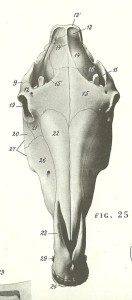 ams from “An Atlas of Animal Anatomy for Artists” by Ellenberger
ams from “An Atlas of Animal Anatomy for Artists” by Ellenberger , Dittrich and Baum, showing that diamond-shaped area at the front of the horse’s head. Run your hand over the front of a real horse’s head and you’ll be able to feel the bone just under the skin in this area.
, Dittrich and Baum, showing that diamond-shaped area at the front of the horse’s head. Run your hand over the front of a real horse’s head and you’ll be able to feel the bone just under the skin in this area.
In fact, there is a slight crevice along the centre of the horse’s head in the middle of the “diamond” (see diagrams above). It always helps to have a midline marker when drawing a complex subject, so feel free to make good use of this one.
In the photo, below, of a fine horse from the Kent-based stud “Dancing Green Lusitanos”, the bone structure is very clear. The left side of the horse’s face is in shadow. See the shape of this shadow, and the clear change of plane between this shaded area and the front of the face. The slight groove down the centre of this horse’s nose is also visible in this picture
Masseter muscle of the cheek
Now consider the semicircular cheek muscle at each side of the head. This is the Masseter muscle, and in real life its surface is almost a flat plane without needing any simplification. On the left, below, is another detail from Ellenberger et al’s “An Atlas of Animal Anatomy for Artists”, the Masseter muscle being labelled with an “m”. On the right is a drawing by Jacques Louis David with the Masseter muscle clearly shown:
Go up to a friendly horse and stroke your hand over the semi-circular Masseter muscle. Feel how flat this muscle is. At the front edge of this muscle, you’ll encounter a sharp change of plane and a “step” as the horse’s head narrows at this point.
The facial crest
Try running your hand up over the flat Masseter muscle towards the eye. Here, you’ll encounter a bony ridge and a definite change of plane. This bony ridge is the zygomatic arch, which is also called the facial crest (labelled 27 in the above diagram). Be aware of this ridge as it is a very prominent feature on every horse head. See how the facial crest is illuminated by sunlight in this photo, and how it casts its own shadow:
This photo of a horse sculpture on an old stable building in New York (below left) clearly shows the structure of the Masseter, facial crest and surrounding planes, as does the photo of a horse, below right):
To further illustrate the marked change of plane at the edge of the masseter muscle, here is a photo of Nic Fiddian-Green working on his horse head sculpture as it is installed at Ascot racecourse. See how there is space for him to fit his body in along the giant horse’s nose while his right arm is in line with the facial crest:
The round Masseter muscle makes a fantastic shape within a composition. Make good use of it if you can.
Here is Delacroix‘s dynamic drawing based on a horse from the Parthenon sculptures. See how hatched lines follow the changing planes to give a clear sense of form. The rounded shape of the Masseter muscle and of the eye contrast here with the more angular, choppy shapes around the nose and ears, contributing to the powerful design:
Position of the eye
Let’s now consider how the eye fits into the head. First, notice that the eye and its lids are embedded within a deep hollow in the skull, the bony orbit. So, though the itself is large and round, only the surface of it protrudes:
The eye within its bony rim is set at an angle. The lowest corner of each eye (the corner nearest to the nose) is closest to the midline. The clearest illustration for that is, again, the New York horse sculpture on the old stable building:
Also see the angle of the eye of this statue by Leonardo da Vinci:
And in the real horse:
What is the widest point of the horse’s head?
The very widest point of the head is at the orbital arch, which is the rim of bone just above and behind the corner of the eye:
The funnel-shape above each nostril
All I shall say about the nose today is that there are muscles in the shape of a funnel or pyramid attached to each nostril. These can pull the rim of the nostril outward to enlarge or dilate the nostril:
The temporal fossa
Note the concave valley, the “temporal fossa” which is just above each eye and a little towards the midline (marked “10” on the diagram below). In some horses this fossa is more of a flat plane. In very thin horses and in those of certain breeds such as Arabs, the temporal fossa is a deep hollow.
The ridge of the Zygomatic arch
There is a bony ridge extending from the upper corner of the eye back towards the base of the ear. This is the “zygomatic arch” (not to be confused with the zygomatic crest) and is labelled “9” on the diagram above.
Here is an Arab horse with a very prominent zygomatic arch extending back from the eye:
The region between the corner of the mouth and the Masseter muscle
The muscles here form ridges and valleys that move as the horse chews food and sometimes when he is excited.
Do look again at the Arab horse profile view, above, to see these muscles clearly defined. In some situations, there is a clear change of plane extending back from the mouth producing a dramatic shadow. See how the light affects these planes in the Arab head above, and also in this close-up view of Robert Glen’s Las Colinas Mustangs (Texas) :
Now what?
The best way to understand the structure of the horse’s head is to get to know a horse in real life, and to feel for yourself where all of those “landmarks” and changes of plane are positioned.
Modelling a horse head in clay or simply in Plasticine will also do wonders to improve your understanding.
This very lengthy post has really just overviewed the structure of the head. I shall happily post in future in more detail, e.g. about the eye area.
News and workshops
I shall be travelling in the coming week, so am taking a short holiday from adding to this blog.
There are still places available on the Horse Life Drawing day on June 17th near Ware, Herts. If you are interested, please do get in touch. You can phone or email if you already know me, otherwise click here: Contact
This workshop is open to all, from sixth form school students up to very experienced artists.
Links
Dancing Green Lusitanos (Kent-based stud with beautiful horses)
“An atlas of Animal Anatomy for Artists” by Ellenberger et.al (My favourite artists’ anatomy book) see link below:
| Tags: anatomy, blog, horses, planar modelling
Sketching pets: which medium to use
May 27, 2012
Sketching pets in various media
Today I discuss which media are best suited to sketching your pet. The illustrations here are pictures from my own sketchbooks, mostly of my Border Terrier, Freddy.
Pen and ink drawing
For the last few years, pen and ink has been the main medium used in my sketchbooks. Both rollerball and cartridge-type pens are wonderfully convenient. There is no mess, they do not spill, fade or smudge. Wherever I go, I usually carry a sketchbook and pen in my bag.
The double-page spread, above, illustrates the adaptability of pen lines for both fl uid “loose” sketching and for a more detailed build-up of detail.
uid “loose” sketching and for a more detailed build-up of detail.
My current favourite sketching pens are Artpens made by Rotring. These have a slightly flexible nib that can produce a “lively” line. I prefer the feel of old-fashioned dip pens even to my Artpens, but, following an incident, am now too nervous of spilling ink to take a dip pen and ink bottle around with me for sketching. The Artpens (“Fine” and “Extra fine”) are a good second best to dip pens.
Above are two drawings made with an Artpen, showing how detail can be built up with crosshatching and fur can be suggested using lines.
Here I had a day of being curious about how things looked from different angles:
In the sketchbook, below, I sat down and drew both plants and my dog with some attention to detail on the right-hand page, again using an Artpen.
The bolder drawings on the left-hand page were drawn in black chinagraph pencil which I shall discuss more fully later in this post.
The only cartridges that can be used in an Artpen are made by Rotring themselves. These are available in various colours. So far I have tried out black and brown inks and these are both watersoluble. A brush pen filled with plain water is handy for working back into the pen lines.
Both the black and brown inks take on a rather purplish tone when water is added. The following drawings (right-hand side of the book) were done with brown Rotring ink in the pen:
See how much bolder the ink drawings look (above) compared with the pencil drawing on their facing page.
Watercolour
I don’t seem to have used watercolour very often for drawing my dog. It can be used very informally in a sketchbook just to fill areas in with a wash of colour. I like to combine watercolour with pen or pencil lines when sketching, often using up whatever colour is left on my palette:
Brush and ink
In the sketchbook, below, I was working on ideas for a still-life picture. The lines for these drawings were made with an Artpen, then dark tone was added using black Daler-Rowney FW ink and a brush. I’ve included this double-page here to show you how this does give quite a striking effect within the sketchbook. Once again, the dog found his way onto the page as a line drawing:
If you are careful to avoid spillage, dilute ink can be carried about in a container and added to a line drawing as you work:
Black Quink ink tends to separate into subtle colours when diluted with water, and this produces an interesting effect:
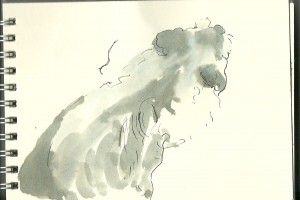
Coloured pencils
The pencils shown above are from the Faber-Castell Polychromos and Derwent Coloursoft ranges, and were used in this drawing:
A few black pen lines were included to increase the definition of the drawing.
The range of wonderful coloured pencils available is tempting. I need little excuse to visit the art shop and to choose yet more colours. A few strokes of one pencil can be used to suggest the exact colour of an animal’s tuft of hair, or light strokes can be layered to blend the colour. Derwent Coloursoft pencils are particularly blendable.
Pencil
Pencil is handy for sketching in that it is very easy to carry around, and is easily erased if errors occur. Unfortunately, it smudges and fades unless fixed, and does not have much impact or reproduce well.
In the following images, I was drawing my own arm in pencil, but then got distracted by the dog who is of course far more interesting:
Chinagraph pencil
Normal coloured pencils produce subtle lines and are easily smudged. For bold, permanent lines consider using a chinagraph pencil. Below is a detail from a double page of my sketchbook. The dog was drawn in coloured pencils and pen, then the rabbits were added in black chinagraph pencil:
The waxy chinagraph pencils are available in black, white and a limited range of other colours. I do find it difficult to keep them sharp, and they easily break when I re-sharpen them. Aside from this frustration, they are great for sketchbook work as they do not smudge at all and encourage a bold, direct approach.
Working in soft pastel
For a completely different effect, try sketching in pastels. Keep the colours simple. It helps to start off each picture with just four colours of your choice: Pick a warm light colour (e.g. a cream), a cool light colour (e.g. a bluish light grey) and a warm and a cool dark colour. In the image below, I used a stick of soft willow charcoal for some of the initial drawing:
The available range of pastel colours is amazing. Once again, I find it hard to stop buying when I am in the art shop. My favourite brand for softness and delicious colour is Unison (right):
I also love to use conte sticks which have a much firmer texture:
For sketching, the main drawback with pastels is their tendency to smudge. They can also leave your hands, bag and surroundings covered with powder.
You may get away with using a little firm conte crayon in your routine sketchbook (leave the facing page blank), but it is advisable to use a dedicated pastel book to protect your work. I like the Daler-Rowney pastel books, which come with textured paper of assorted colours. Each page is protected by its own piece of greaseproof-type paper, so your work won’t smudge when you turn the page.

Looking ahead…
I am looking forward to the next horse life drawing class which is set for Sunday June 17th:
https://art2art.org.uk/workshops/equestrian-life-drawing-sunday-june-17
Do contact me to reserve your place.
My next post will probably be related to drawing horses. Let me know if you have any special requests for post topics, otherwise just watch this space!
